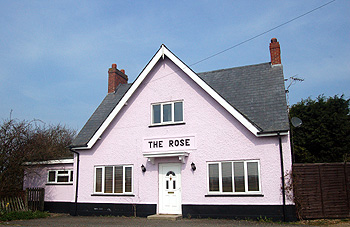The Rose Public House Wilshamstead
![The Rose about 1925 [WL800/4]](/CommunityHistories/Wilstead/WilsteadImages/The Rose about 1925 [WL800-4].jpg)
The Rose about 1925 [WL800/4]
The Rose Public House: Cotton End Road, Wilshamstead
The Rose began life as a beerhouse. The countywide licensing register of 1876 states that this was over forty years previously. The establishment is not listed in the run of countywide licensing registers from 1822 to 1818 [CLP13] indicating that it probably opened for the first time between 1828 and 1836. In 1876 the owner was “Miss Cowlin of Cardington” – this was, in fact, Mary Cowland. She was still the owner in 1903 when the countywide licensing register noted that the premises was in fair repair and was clean but had no urinal. The nearest licensed premises (the Carpenters Arms) was three-quarters of a mile away and the property had two front doors and one at the back.
The Rating and Valuation Act 1925 specified that every building and piece of land in the country was to be assessed to determine its rateable value. Like most of the county, Wootton was largely assessed in 1927 and the valuer visiting the Rose [DV1/C65/116] found it now owned by Charles Wells Limited and occupied by Benjamin Cambers whose rent, nor trade was not stated because he was: “out 9/6/1927. Referenced from outside”. Unfortunately the deeds relating to the Rose have not been deposited with Bedfordshire and Luton Archives and Records Service by Charles Wells (who have deposited deeds to most of their licensed premises with us) so it is not possible to say when the firm bought the property.
The inability of the valuer to enter the property led to a description of a brick and slate house – “fairly old”. The valuer spotted a tap room, a parlour, a kitchen and a storeroom and reckoned there would be three or four bedrooms upstairs. Three old sheds, a hovel and a barn all stood outside.
Charles Wells applied for planning permission to rebuild the house in 1927 [RDBP1/1123] it was at this point, presumably, that the Rose changed drastically from the building in the photograph at the top of this page to that below. Permission was sought to add a garage the following year [RDBP1/1192]. In 1934 they applied for permission for an outbuilding to house a portable forge [RDBP2/580] and to make alterations in 1936 [RDBP2/956]. The final record for the public house (as it became when it was fully licensed on 7th March 1936) is an application for planning permission for an extension and a car park in 1987 [BorB/TP/87/2388]. At some point after 1996 the Rose closed its doors for the last time and is now a private house.

The former Rose Public House March 2011
Records:
- ST/U4/28: valuer’s notebook: 1898-1899;
- PSB9/1: register of licenses: 1903-1935;
- WL800/4: photograph: c. 1925;
- RDBP1/1123: plans for rebuilding: 1927;
- RDBP1/1192: plans for garage: 1928;
- RDBP2/580: plan for outbuilding for portable forge: 1934;
- RDBP2/956: plans for alterations: 1936;
- PSB9/2: register of licenses: c.1955-1995;
- BorB/TP/87/2388: plans for extension and car park: 1987.
List of Licensees: note that this is not a complete list. Italics indicate licensees whose beginning and/or end dates are not known:
1864-1898: George Arnold;
1903: Frederick Thomas Cox;
1903: Charles Harry Francis;
1903-1906: John William Collins;
1906-1909: Herbert Masters;
1909-1928: Benjamin Cambers;
1928-1932: Thomas William Fensome;
1932-1936: Frank Reginald Dennis;
1940: Charles Joseph Greenwood
1965-1966: Jack Ransome;
1966: Sydney Lawrence Jennings;
1966-1968: Richard Lawrence Faulkner;
1968-1973: Arthur John Santer;
1973-1975: John George Major;
1975-1978: Eric Endersby;
1978-1982: Peter Arthur Kenneth Batten;
1982-1983: Christopher John Minns;
1983-1984: Thomas David Williams;
1984-1986: Richard John Green;
1986-1991: Ronald Leonard Chambers;
1991-1992: Anthony W. Thornton;
1992-1993: John C. Robinson;
1993-1995: Anthony William Thornton.